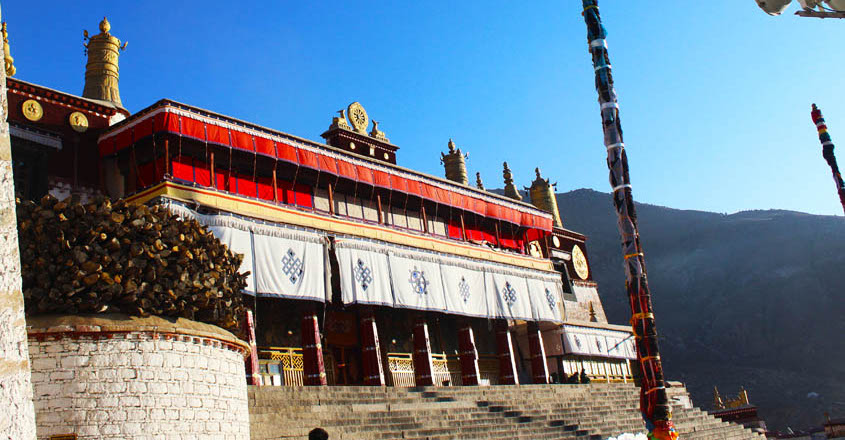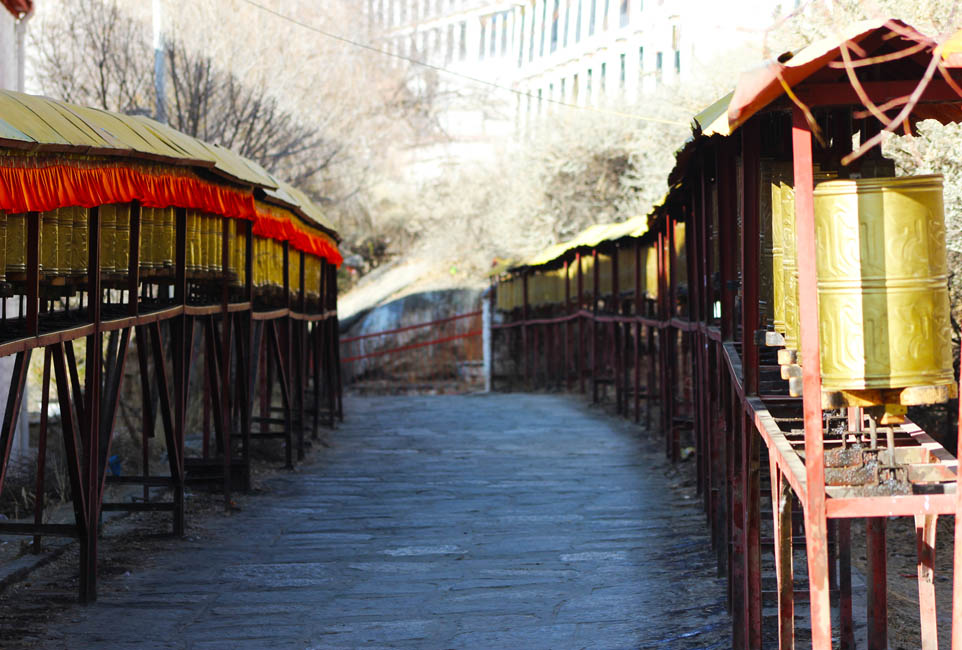+86-15889090408
[email protected]
Drepung Monastery is located eight kilometers northwest of Lhasa on the Gephel Utse ridge above West Deky Lam. It was founded in 1416 by Jamyang Choje Tashi Palden (1397-1449), and named after the sacred abode of Shridhanyakataka in South India. Jamyang Choje was one of Tsongkhapa’s foremost disciples, and it is known that Tsongkhapa himself taught at the site of the new monastery.
The complex developed rapidly with the assistance of the Phakmodru kings, especially Nedong Namka Zangpo so there were 2,000 monks in its second year of existence.
In the early years of the 16th century, the 2nd Dalai Lama took possession of the Ganden Podrang at Drepung, which was later to become an important center of political power in Tibet. At the time when the 5th Dalai Lama assumed spiritual and temporal power in 1641, Drepung had over 10,000 monks, who hailed from 321 different branch monasteries and lived according to nationality in 50-60 different houses, making it the largest monastery in the world.

Drepung’s influence within the Gelukpa world extended far to the east and northeast through Amdo and Mongolia. The abbot-preceptor of Drepung, known as the Tripa Khenpo, was formerly an influential figure within the Tibetan government.
Much of the 20,000 square meters complex at Drepung has survived unscathed, despite repeated plunder inflicted upon it – by King Tsangpa Desi of Zhigatse during the civil war in 1618, by the Mongols in 1635, by Lhazang Can in 1706, and by the Chinese during the recent Cultural Revolution. Many of the surviving buildings date from the 17th-18th century.
The monastery reopened in 1980, with a population of approximately 500, most of them young novices, but in recent years the numbers have been considerably reduced in consequence of the active program of political indoctrination initiated here by the communist party cadres.
The complex comprises the Central Assembly Hall (Tsokchen Lhakhang), the Ganden Palace (Ganden Podrang), and a series of seven colleges (Tratsang), each originally under the control of one or other of Jamyang Choje’s students, and each containing its own residential units (Khangtsang).
Four of these colleges survive to the present, namely: Ngakpa, Loseling, Deyang, and Tashi Gomang. The other three, Dulwa, Sha-Khor, and Tosamling. Unfortunately, declined during the 18th century.
The pilgrim’s circumambulation route around Drepung follows the sequence described here, viz: Ganden Podrang, Assembly Hall, Ngakpa Tratsang, Jamyang Lhakhang, Loseling Tratsang, Tashi Gomang Tratsang, and Deyang Tratsang.

In 1518 the magnificent residence of Dokhang Ngonmo in the southwest of Drepung was offered by Miwang Tashi Drakpa of Phakmodru to the 2nd Dalai Lama, and its name was thereafter changed to Ganden Podrang. It continued to function as the residence of the successive Dalai Lamas until the 5th Dalai Lama moved into the newly reconstructed Potala Palace in the late 17th century. Nonetheless, the government established by him continued to refer to itself by the name Ganden Podrang until 1959.
Left of the entrance gateway is the Sangak Podrans which serves as a protector shrine. The outer chamber contains an image of Dalai Lama V the throne of the Dalai Lamas; above which exquisite applique tangkas are suspended, and backed by glass-cased images of the meditational deities Guhyasamaja, Cakrasamvara, and Bhairava; as well as Tsongkhapa and his foremost students. Attached to the side walls are elevated bookcases containing manuscript volumes of the Kangyur and Tangur. The inner sanctum with its distinctive gold on black murals contains images of Dharmarja Bhairava, Six-armed Mahakala, and Shridevi.
At the northern perimeter of the terrace, is a steep flight of stairs leading to the main courtyard, where religious dances were once performed and where the Drepung Yoghurt Festival even now begins in the summertime. This courtyard is flanked by two-story residential quarters, which were once occupied by the monks of Namgyel Monastery (before their move to the Potala Palace).
Beyond the courtyard, the lower story of the palace contains an Assembly Hall, which houses Atisha’s personal image of ‘speaking’ Tara (Dolma Sungjonma), and other images of Mahakarunika, and the protector deities.
The upper floor contains the Private Apartments of the Dalai Lamas, which have images of Tsongkhapa with his main students, and an elaborate throne. The 4,500 square meters three-story central assembly hall is the largest and grandest building in Drepung, rebuilt by Miwang Sonam Topgyel in 1735.
Its wide terrace, approached by a flight of 17 steps, overlooks the city of Lhasa and the Kyi-chu valley. The entrance actually in use is a gateway on the left side of the building.
Ground Floor The main hall on the ground floor (50 meters by 36 meters) has 182 columns and the two-storeyed central atrium is well lit from above. On the left side of the hall is the Lubum Lhakhang, containing two sunken stupas blessed by the Nagas, and the silver-plated reliquary stupas of the 3rd Dalai Lama and 4th Dalai Lama, which are accessible to the public only on the eighth day of the seventh lunar month during the Yoghurt Festival.

This college dedicated to tantric studies is located west of the Central Assembly Hall. It was founded in 1419, originally to admit into tantric studies graduates of the other exoteric colleges. Adepts of the Ngakpa Tratsang would subsequently be admitted to the Upper Tantric College (Gyuto) or the Lower Tantric College (Gyume) in Lhasa.
The assembly hall (Dukhang) which is the latter of the two main buildings has images of the Indo-Tibetan lamrim lineage-holders, with Tsongkhapa and various Dali Lamas at the center. The Jikje Lhakhang behind the assembly hall was constructed by Tsongkhapa himself and houses the sacred image of Bhairava known as ‘Chogyel Caktakma’, Dharmaraja holding an iron chain. The embalmed remains of Ra Lotsawa are contained within this image. Other statues here depict Dorje Drakden, Mahakala, Shridevi, Dalai Lama V, and Tsongkhapa.

The college of dialectics, known as Loseling (1,860 square meters), is located southeast of the Central Assembly Hall. The abbot-preceptor of Loseling was highly influential, presiding over 23 residential units (khangtsang).
The assembly hall has 102 columns, and it contains numerous volumes of scripture. From left to right the main images and sacred objects are the reliquary stupa of Loseling Tripa I Legden Rinpoche; the reliquary stupa of the late Kangyur Rinpoche; images of Dalai Lamas V, VIII, and VII; a Bhairava mandala and image of Jamyang Choje; images of Tsongkhapa and Dalai Lama XIII; the reliquary stupa of Loseling Dedrub Rinpoche; and images of Tsongkhapa with his foremost students, and Sitatapatra. The niches of the sidewalls hold 1,000 small images of Amitayus.
There are three inner sanctums. In succession, these are: Neten Lhakhang which has images of the Sixteen Elders in three tiers flanking an Enlightenment Stupa; the Jampa Lhakhang which has a large Maitreya with Shakyamuni Buddha (left), Tsongkhapa (right), and Dalai Lama XIII (center), as well as Atisha, flanked by Dromtonpa and Ngok Lekpei Sherab; and the
Tunpa Lhakhang has a small Shakyamuni image flanked by stupas. The upper level has a Protector Chapel accessible only to males. Here, Bhairava is flanked by the meditational deities Guhyasamaja, Cakrasamvara, and the protector Mahakala.

Located east of Loseling, this is the second-largest college at Drepung, with 16 residential units (khangtsang). Traditionally it housed monks from Amdo, Mongolia, and Nakchuka. The assembly hall has 102 columns, and images left to right) of: Six-armed Mahakala (twice), Dalai Lama VI, Tsongkhapa (four), Dipamkara Buddha, Avalokiteshvara , Dalai Lama VII,
Maitreya, Amitayus, and Jamyang Choje. Distinctive murals depict the 108 episodes in the life of Shakyamuni Buddha. There are three inner sanctums, in succession: Tsepak Lhakhang which has images of the Three Deities of Longevity; the Mikyopa Lhakhang which has three tiers of images, with Aksobhya at the center of the top tier, flanked by Shakyamuni and a smaller Aksobhya. The middle tier has Shakyamuni, Avalokiteshvara, Maitreya, and a small Tsongkhapa in front; and on the lowest tier, there are five images of the celebrated Gomang lama Jamyang Drepa.
Lastly, the Dolma Lhakhang has tiered images of the Twenty-one Taras and the Sixteen Elders. In its second story is a protector shrine dedicated to Dorji Drakden. Here, the central image is Mahakala, flanked by Bhairava and various local deities.

This is the smallest of the four Tratsang, which is dedicated to the Medicine Buddhas. The assembly hall has images of Tsongkhapa with his foremost students, Sitatapatra, White and Green Tara, and Dalai Lama V; while its gatekeepers are the protector deities Dorje Drakden and Shridevi.
The Jowokhang at the rear of the assembly hall contains an image of Maitreya flanked on the left by Deyang Jangchub Palden and Dalai Lama VIL, and on the right by Tsongkhapa, Shakyamuni, Dalai Lama III, Rato Tripa I Yonten Gyatso, and Deyang Tripa II. The monastic kitchen lies east of the assembly hall.

There is a one-and-a-half-hour pilgrim’s circumambulation of Drepung Monastery, which leads west of the perimeter wall and uphill in the direction of Gephel Retro, before descending in the direction of Nechung. En route, the following features of sacred geography are observed: four ‘self-arising’ golden fish at Ganden Podrang, Tashi Kangsar, Ngakpa Tratsang, and Gungru Kham-Tsang respectively; a ‘self-arising’ Green Tara called Dolma Kang Chakma; other paintings of Tara at Chiri Rizur, a ‘self-arising’ Jambhala, a stone throne associated with Dalai Lama V; and a ‘self-arising stone engraved with the Six Syllable Mantra of Avalokiteshvara.